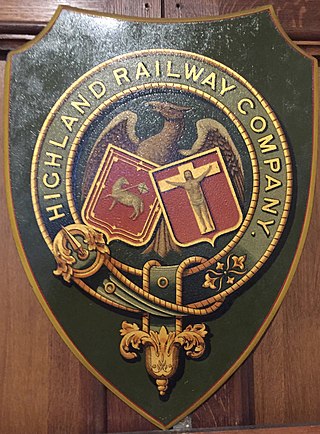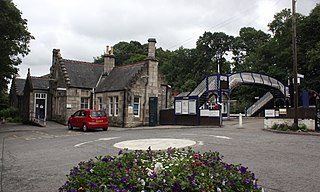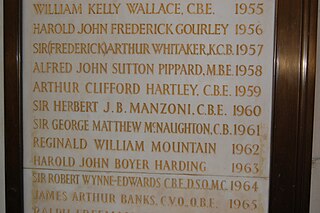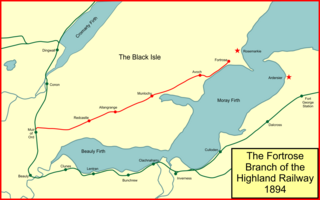Related Research Articles

The Highland Railway (HR) was one of the smaller British railways before the Railways Act 1921, operating north of Perth railway station in Scotland and serving the farthest north of Britain. Based in Inverness, the company was formed by merger in 1865, absorbing over 249 miles (401 km) of line. It continued to expand, reaching Wick and Thurso in the north and Kyle of Lochalsh in the west, eventually serving the counties of Caithness, Sutherland, Ross & Cromarty, Inverness, Perth, Nairn, Moray and Banff. Southward it connected with the Caledonian Railway at Stanley Junction, north of Perth, and eastward with the Great North of Scotland Railway at Boat of Garten, Elgin, Keith and Portessie.
Chief mechanical engineer and locomotive superintendent are titles applied by British, Australian, and New Zealand railway companies to the person ultimately responsible to the board of the company for the building and maintaining of the locomotives and rolling stock. In Britain, the post of locomotive superintendent was introduced in the late 1830s, and chief mechanical engineer in 1886.

The Highland Main Line is a railway line in Scotland. It is 118 mi (190 km) long and runs through the central Scottish Highlands, mainly following the route of the A9, and linking a series of small towns and villages with Perth at one end and Inverness at the other. Today, services between Inverness and Edinburgh, Glasgow and London use the line. At Inverness the line connects with the Far North Line, the Aberdeen-Inverness Line and the Kyle of Lochalsh Line. All trains are diesel-powered.
The Highland Railway River class was a class of steam locomotive with a 4-6-0 wheel arrangement. They were designed by F. G. Smith, who had joined the Highland Railway in 1904 from the North Eastern Railway. His initial post was as manager of the Locomotive, Carriage and Wagon works at Inverness. When Peter Drummond departed to the Glasgow and South Western Railway at the end of 1911 Smith was appointed Chief Mechanical Engineer in his place.

The Aberdeen–Inverness line is a railway line in Scotland linking Aberdeen and Inverness. It is not electrified. Most of the line is single-track, other than passing places and longer double-track sections between Insch and Kennethmont and Inverurie and Berryden Junction (Aberdeen).

Elgin railway station is a railway station serving the town of Elgin, Moray in Scotland. The station is managed and served by ScotRail and is on the Aberdeen to Inverness Line, between Keith and Forres, measured 12 miles 18 chains (19.7 km) from Forres.

Pitlochry railway station is a railway station serving the town of Pitlochry in Perth and Kinross, Scotland. It is managed by ScotRail and is located on the Highland main line, 28 miles 21 chains (45.5 km) from Perth, between Dunkeld & Birnham and Blair Atholl.

William Kelly Wallace CBE (1883–1969) was an Irish railway engineer who joined the Northern Counties Committee and later became Chief Civil Engineer of the London Midland and Scottish Railway (LMS). He was awarded a civil CBE in the 1946 New Year Honours.
The Inverness and Aviemore Direct Railway was a section of railway built by the Highland Railway to provide a shorter and more direct route between Inverness and Aviemore, carrying its main line traffic to Perth and the south.
The Strathspey Railway was a railway company in Scotland that ran from Dufftown to Boat of Garten. It was proposed locally but supported by the larger Great North of Scotland Railway (GNoSR), which wanted to use it as an outlet towards Perth. The GNoSR had to provide much of the funding, and the value of traffic proved to be illusory. The line opened in 1863 to Abernethy, but for the time being was unable to make the desired connection to the southward main line. Although later some through goods traffic developed, the route never achieved its intended purpose.

The Fortrose Branch, also known as the Black Isle Railway, was a railway branch line serving Fortrose in the Black Isle, in the north of Scotland. It was built by the Highland Railway as a tactical measure to exclude a rival railway company and to move the locals from Fortrose onwards to other destinations.
The Buckie and Portessie Branch was a railway branch line in Scotland, built by the Highland Railway to serve an important fishing harbour at Buckie, in Banffshire. It connected with the rival Great North of Scotland Railway at Portessie.

Ernest Frederic Crosbie Trench CBE, TD was a British civil engineer.
Vernon Alec Murray Robertson, CBE, MC and bar was a British civil engineer in the railway sector. During the First World War he served with the Royal Engineers with distinction, earning the Military Cross twice. Robertson later worked for a number of railway companies before becoming Chief Civil Engineer to the London Passenger Transport Board, Southern Railway and the Southern Region of British Railways. During and after the Second World War he returned to the army and served with, and commanded, the Engineer and Railway Staff Corps. Robertson served as president of the Institution of Civil Engineers for 1949–50.

Alexander Ross was a British civil engineer particularly noted for his work with the railway industry.
Sir Charles Langbridge Morgan CBE was a British civil engineer. A railway engineer, he spent his early career on several railway construction projects before joining the Great Eastern Railway where his responsibilities included construction of Liverpool Street station. Morgan became chief engineer of the London, Brighton and South Coast Railway in 1896 and directed improvements to London Victoria station and Grosvenor Bridge. During the First World War Morgan was a lieutenant-colonel in the Royal Engineers, carrying out "special engineering duties" in Italy and France for the War Office. He later served as the army's deputy director of railways, on the advisory expert committee to the Ministry of Munitions and on the Disposal Board of the Disposal and Liquidation Commission.

The Institution of Engineers and Shipbuilders in Scotland (IESIS) is a multi-disciplinary professional body and learned society, founded in Scotland, for professional engineers in all disciplines and for those associated with or taking an interest in their work. Its main activities are an annual series of evening talks on engineering, open to all, and a range of school events aimed at encouraging young people to consider engineering careers.
Events from the year 1816 in Scotland.
Murdoch Paterson was an engineer and architect based in Inverness, Scotland, who was chief engineer of the Highland Railway.
Angus John Beaton (1858–1945) was a Scottish engineer best known for his contribution to the development of railways in South Africa. He served on the Field Intelligence Staff in the South African Field Force, 7th Dragoon Guards in the Anglo-Boer War from October 1900 to May 1902.
References
- ↑ "Railway Engineer of Note" . Aberdeen Press and Journal. Scotland. 29 August 1938. Retrieved 20 February 2022– via British Newspaper Archive.
- ↑ "Chief Engineer of Highland Railway" . Dundee Courier. Scotland. 30 October 1913. Retrieved 20 February 2022– via British Newspaper Archive.
- ↑ "1922-1933". Special Collections:Retired: 225. 1922. Retrieved 20 February 2022.
- ↑ "No. 31840". The London Gazette . 26 March 1920. p. 3769.
- ↑ Newlands, Alexander (1921). The Scottish Railway. A Sketch of their Growth and Development. Railway Gazette.
- ↑ Newlands, Alexander (1936). The British Railways. Longmans, Green and Company.